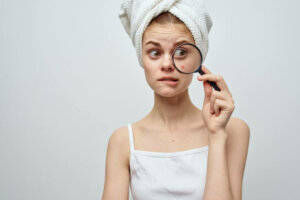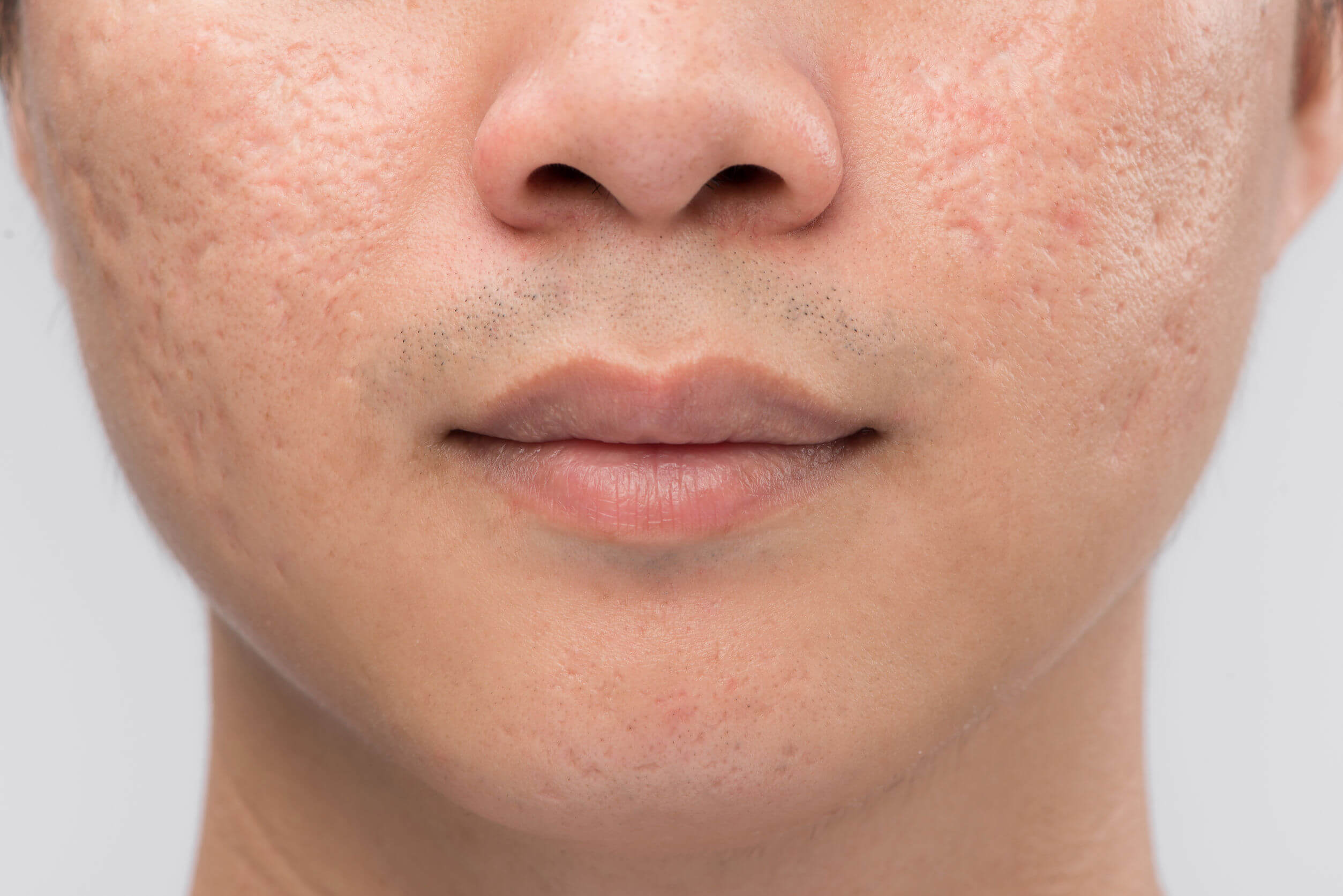Signs and Symptoms of Acne

Usually the signs and symptoms of acne are what we normally call blemishes. They’re located in the area of the face, neck and other areas of the upper body, but they aren’t always the same. Sometimes they can appear in the form of small spots, in others as swollen, red, large pimples.
Acne is one of the most common skin disorders worldwide. Although acne was long considered to be a condition unique to adolescence, over time it has been shown that this isn’t the case.
In fact, it affects men and women of almost any age and can have various manifestations. Next up, we’ll look at some of the most frequent.
Frequent symptoms

As the MSD Manual explains, acne occurs as a consequence of various factors. It’s caused by the obstruction of the hair follicles through the accumulation of dry sebum, dead cells, and bacteria.
The lesions caused by acne can vary in size and severity. Regarding the latter, it must be taken into account that the more they penetrate the skin, the greater the impact. The most common symptoms of acne can be inflammatory or non-inflammatory in nature.
The lesions usually develop mostly on the face and neck, but they can also spread to other parts of the body, such as the chest, shoulders, back, and even the buttocks.
Non-inflammatory acne symptoms
Comedogenic acne doesn’t cause inflammation or redness in the area of the lesions. However, it can lead to blocked pores and then cause:
- Blackheads (open comedones)
- Whiteheads (closed comedones)
- Microcomedones (not visible to the naked eye)
Inflammatory acne symptoms
Continuing with what the MSD Manual states, with inflammatory acne, the symptoms would be the following.
- Pimples (inflamed closed comedones)
- Papules (solid raised lesions of variable size)
- Pustules (superficial, red, pus-containing bumps)
Rare symptoms
To a lesser extent, acne can cause nodules and cysts, which are lesions that can reach the deeper layers of the skin and cause a lot of pain. Consequently, they require more specific, rigorous and prolonged treatment than, for example, cases of mild acne.
- Nodules are pus-containing bumps that affect the deeper layers of the skin.
- Cysts (vesicles with large pus). These can get worse and turn into abscesses.
If cases of severe acne aren’t treated properly in time, both nodules and cysts can lead to the appearance of various complications, which, fortunately, can be treated.
Complications

The signs and symptoms of acne can lead to various complications. Not only when there’s an absence of adequate treatment, but also when the person insists on touching the lesions frequently, in an attempt to eliminate them.
“Squeezing the pimples or trying to open them increases the inflammation and the depth of the lesion, and this makes it more likely that scars (hypertrophic or elevated) will form”, explains the aforementioned manual. On the other hand, manipulation of the spots can lead to the appearance of post-inflammatory hyperpigmentation.
According to the Spanish Academy of Dermatology and Venereology, excoriated acne is a particular clinical form of acne. In general, it manifests itself in patients who are very concerned about their condition, even when it is minimal. They scratch themselves and, in the end, they end up making their situation worse.
When to see a dermatologist?
The more severe the acne or the more it affects the person physically and psychologically, the more it’s recommended that you go to the dermatologist without delay.
Some people don’t consider acne to be too much of a problem, because they think it doesn’t affect them in their day-to-day lives. However, ideally, you should consult a dermatologist. In this way, the most appropriate treatment can be obtained right from the start, improving the skin’s health, and preventing complications, especially scars.
Do you think you have some of the signs and symptoms of acne that we mentioned above? If so, we recommend that you avoid touching the area (face, neck, back, etc.) and go to your trusted dermatologist.
Usually the signs and symptoms of acne are what we normally call blemishes. They’re located in the area of the face, neck and other areas of the upper body, but they aren’t always the same. Sometimes they can appear in the form of small spots, in others as swollen, red, large pimples.
Acne is one of the most common skin disorders worldwide. Although acne was long considered to be a condition unique to adolescence, over time it has been shown that this isn’t the case.
In fact, it affects men and women of almost any age and can have various manifestations. Next up, we’ll look at some of the most frequent.
Frequent symptoms

As the MSD Manual explains, acne occurs as a consequence of various factors. It’s caused by the obstruction of the hair follicles through the accumulation of dry sebum, dead cells, and bacteria.
The lesions caused by acne can vary in size and severity. Regarding the latter, it must be taken into account that the more they penetrate the skin, the greater the impact. The most common symptoms of acne can be inflammatory or non-inflammatory in nature.
The lesions usually develop mostly on the face and neck, but they can also spread to other parts of the body, such as the chest, shoulders, back, and even the buttocks.
Non-inflammatory acne symptoms
Comedogenic acne doesn’t cause inflammation or redness in the area of the lesions. However, it can lead to blocked pores and then cause:
- Blackheads (open comedones)
- Whiteheads (closed comedones)
- Microcomedones (not visible to the naked eye)
Inflammatory acne symptoms
Continuing with what the MSD Manual states, with inflammatory acne, the symptoms would be the following.
- Pimples (inflamed closed comedones)
- Papules (solid raised lesions of variable size)
- Pustules (superficial, red, pus-containing bumps)
Rare symptoms
To a lesser extent, acne can cause nodules and cysts, which are lesions that can reach the deeper layers of the skin and cause a lot of pain. Consequently, they require more specific, rigorous and prolonged treatment than, for example, cases of mild acne.
- Nodules are pus-containing bumps that affect the deeper layers of the skin.
- Cysts (vesicles with large pus). These can get worse and turn into abscesses.
If cases of severe acne aren’t treated properly in time, both nodules and cysts can lead to the appearance of various complications, which, fortunately, can be treated.
Complications

The signs and symptoms of acne can lead to various complications. Not only when there’s an absence of adequate treatment, but also when the person insists on touching the lesions frequently, in an attempt to eliminate them.
“Squeezing the pimples or trying to open them increases the inflammation and the depth of the lesion, and this makes it more likely that scars (hypertrophic or elevated) will form”, explains the aforementioned manual. On the other hand, manipulation of the spots can lead to the appearance of post-inflammatory hyperpigmentation.
According to the Spanish Academy of Dermatology and Venereology, excoriated acne is a particular clinical form of acne. In general, it manifests itself in patients who are very concerned about their condition, even when it is minimal. They scratch themselves and, in the end, they end up making their situation worse.
When to see a dermatologist?
The more severe the acne or the more it affects the person physically and psychologically, the more it’s recommended that you go to the dermatologist without delay.
Some people don’t consider acne to be too much of a problem, because they think it doesn’t affect them in their day-to-day lives. However, ideally, you should consult a dermatologist. In this way, the most appropriate treatment can be obtained right from the start, improving the skin’s health, and preventing complications, especially scars.
Do you think you have some of the signs and symptoms of acne that we mentioned above? If so, we recommend that you avoid touching the area (face, neck, back, etc.) and go to your trusted dermatologist.
- Acne clinical guideline [Internet]. [cited 2021 Jun 25]. Available from: https://www.aad.org/member/clinical-quality/guidelines/acne
- Bernabéu A. Acné. Etiología y tratamiento. Offarm [Internet]. 2008 [cited 2021 Jun 25];76–80. Available from: https://www.elsevier.es/es-revista-offarm-4-articulo-acne-etiologia-tratamiento-13126071
- Hazarika N, Archana M. The psychosocial impact of acne vulgaris. Indian J Dermatol. 2016 Sep 1;61(5):515–20.
- Keri JE. Acné – Trastornos de la piel – Manual MSD versión para público general [Internet]. Manual MSD- Versión para público general. [cited 2021 Jun 25]. Available from: https://www.msdmanuals.com/es/hogar/trastornos-de-la-piel/acné-y-trastornos-relacionados/acné
- Morales N, Aristizábal AM. Cicatrices de acné, un reto terapéutico. Rev Asoc Colomb Dermatol [Internet]. 2013 [cited 2021 Jun 25];21(4):328–36. Available from: https://revistasocolderma.org/sites/default/files/cicatrices_de_acne_un_reto_terapeutico.pdf
Este texto se ofrece únicamente con propósitos informativos y no reemplaza la consulta con un profesional. Ante dudas, consulta a tu especialista.







